
Theorem is a geometrical statement which is true and can be proved by
using known facts and axioms. Generally, we prove geometrical theorems by two
methods, one method is experimental
verification and another method is theoretical
proof.
Some of the triangle
theorems and their experimental verification and/or theoretical proofs are
given below:
********************
10 Math Problems officially announces the release of Quick Math Solver and 10 Math Problems, Apps on Google Play Store for students around the world.
********************
********************
Theorem 1:
“Among the straight
lines drawn from an external point to a given straight line, the perpendicular
is the shortest one.”
Experimental Verification
PA, PB, PM and PN are the straight lines drawn from a point P to
the line XY and PA⊥XY. Three such figures are
drawn with the help of scale, pencil and protractor.

Table,

Conclusion: It is
experimentally verified that the perpendicular drawn from a point to the
straight lines is the shortest distance from the point to the line.
Theorem 2:
“The sum of two sides
of a triangle is greater than the third side.”
Experimental Verification
Three triangles ABC of different shapes and sizes are drawn with
the help of scale and pencil.

Table,

Conclusion: It is
experimentally verified that the sum of two sides of a triangle is greater than
the third side.
Theorem 3:
“In a triangle, the
side opposite to the greater angle is longer than the side opposite to the
smaller angle.”
Experimental Verification
Three triangles PQR of different shapes and sizes with ∠P greater than other angles ∠Q and ∠R are drawn with the help of scale and pencil.
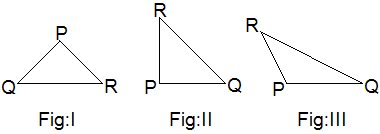
Table,

Conclusion: Hence it is
experimentally verified that the side opposite to greater angle is longer than
the side opposite to smaller angle.
Theorem 4:
“The sum of three angles of a triangle is equal to two right angles.”
Experimental Verification
Three triangles ABC of different shapes and sizes are drawn with
the help of scale and pencil.

Table,

Conclusion: Hence it is
experimentally verified that the sum of the angles of a triangle is two right
angles.
Theoretical Proof:

Given: ABC is a triangle.
To prove: ∠ABC+∠BAC+∠ACB = 180°
Construction: Through A, PQ
parallel to BC is drawn.
Proof:
Statements
Reasons
1. ∠PAB = ∠ABC ------> Alternate angles
2. ∠QAC = ∠ACB -------> Alternate angles
3. ∠PAB+∠BAC+∠QAC = 180° ----->
Straight angle
4. ∠ABC+∠BAC+∠ACB = 180° -----> From
statements 1, 2 and 3.
Proved.
Theorem 5:
“The exterior angle
of a triangle is equal to the sum of the two interior opposite angles.”
Experimental Verification
Three triangles PQR with exterior angle ∠PRS are drawn with the help of scale and pencil.

Table,

Conclusion: Hence it is
experimentally verified that the exterior angle of a triangle is equal to the
sum of the two interior opposite angles.
Theoretical Proof:

Given: In ∆ABC, ∠ACD is an exterior angle.
To prove: ∠ACD = ∠A + ∠B
Proof:
Statements Reasons
1. ∠ACB + ∠ACD = 180° -----> Straight angle.
2. ∠A+∠B+∠ACB = 180° -----> Sum
of angles of a ∆.
3. ∠ACB+∠ACD = ∠A+∠B+∠ACB -----> From
statements 1 and 2.
4. ∠ACD = ∠A+∠B ------> Removing ∠ACB from both sides.
Proved.
Theorem 6:
“Base angles of an
isosceles triangle are equal.” OR “If two sides of a triangle are equal, then
the angles opposite to them are also equal.”
Experimental Verification
Three isosceles triangles PQR of different shapes and sizes with
PQ = PR are drawn with the help of scale, pencil and compass.
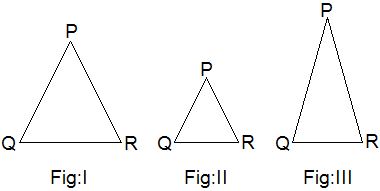
Table,

Conclusion: Hence it is
experimentally verified that if two sides of a triangle are equal then the
angles opposite to them are also equal.
Theoretical Proof:
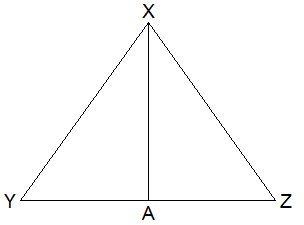
Given: ∆XYZ is an isosceles
triangle in which XY = XZ.
To prove: ∠XYZ = ∠YZX
Construction: XA⊥YZ drawn.
Proof:
Statements Reasons
1. In ∆XYA and ∆XZA
i. ∠XAY = ∠XAZ (R) ------> Both right angles.
ii. XY = XZ (H) ------> Given.
iii. XA = XA (S)
------> Common side.
2. ∆XYA ≅ ∆XZA ------> By RHS axiom.
3. ∠XYA = ∠XZA -----> Corresponding angles of congruent triangles
4. ∠XYZ = ∠YZX -----> From statement 3.
Proved.
Theorem 7:
“In a triangle, the
sides opposite to the equal angles are also equal.”
Experimental Verification
Three triangles PQR of different shapes and sizes with ∠Q = ∠R are drawn with the help
of scale, pencil and protractor.

Table,

Conclusion: Hence it is
experimentally verified that the sides opposite to equal angles in a triangle
are equal.
Theoretical Proof:
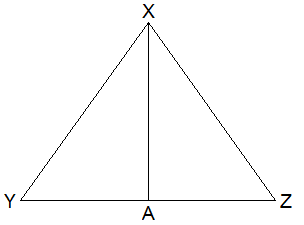
Given: In ∆XYZ, ∠Y = ∠Z.
To prove: XY = XZ
Construction: XA⊥YZ drawn.
Proof:
Statements
Reasons
1. In ∆XYA and ∆XZA
i. XA = XA (S)
-------> Common side.
ii. ∠XAY = ∠XAZ (A) -------> Both
right angles.
iii. ∠Y = ∠Z (A) -------> Given.
2. ∆XYA ≅ ∆XZA -------> By SAA axiom.
3. XY = XZ -------> Corresponding sides of congruent
triangles.
Proved.
Theorem 8:
“The bisector of the
vertical angle of an isosceles triangle is perpendicular to the base and
bisects the base.”
Experimental Verification
Three triangles PQR with bisector PX of different shapes and
sizes are drawn with the help of scale, pencil and compass.
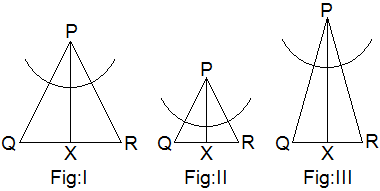
Table,

Conclusion: Hence it is
experimentally verified that the bisector of vertical angle of an isosceles
triangle is perpendicular to the base and bisects the base.
Theoretical Proof:

Given: ∆XYZ is an isosceles
triangle in which XY = XZ. XA is bisector of ∠YXZ i.e. ∠AXY = ∠AXZ.
To prove: XA⊥YZ and YA = ZA
Proof:
Statements
Reasons
1. In ∆XYA and ∆XZA
i. XY = XZ (S)
-------> Given.
ii. ∠AXY = ∠AXZ (A) -------> Given.
iii. XA = XA (S)
-------> Common side.
2. ∆XYA ≅ ∆XZA -------> By SAS axiom.
3. ∠XAY = ∠XAZ -------> Corresponding angles of congruent triangles.
4. XA⊥YZ -------> Being
adjacent angles equal (statement 3).
5. YA = ZA ------> Corresponding sides of congruent
triangles.
Proved.
Theorem 9:
“The line joining the
mid-points of the base of an isosceles triangle to the opposite vertex is
perpendicular to the base and bisects the vertical angle.”
Experimental Verification
Three triangles PQR with A as mid-point of QR of different shapes
and sizes are drawn with the help of scale, pencil and compass.

Table,

Conclusion: Hence it is
experimentally verified that the line joining mid-point of the base of an
isosceles triangle to the opposite vertex is perpendicular to the base and
bisects the vertical angle.
Theoretical Proof:
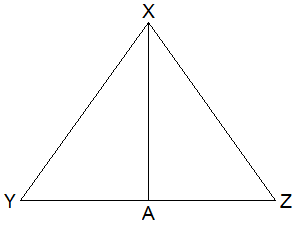
Given: ∆XYZ is an isosceles
triangle in which XY = XZ. A is the mid-point of YZ i.e. AY = AZ.
To prove: XA⊥YZ and ∠AXY = ∠AXZ
Proof:
Statements Reasons
1. In ∆XYA and ∆XZA
i. XY = XZ (S) --------> Given.
ii. AY = AZ (S) --------> Given.
iii. XA = XA (S)
-------> Common side.
2. ∆XYA ≅ ∆XZA --------> By SSS axiom.
3. ∠XAY = ∠XAZ -------> Corresponding angles of congruent triangles.
4. XA⊥YZ -------> Being
adjacent angles equal (statement 3).
5. ∠AXY = ∠AXZ -------> Corresponding angles of congruent triangles.
Proved.
Theorem 10:
“A line segment
joining the mid-points of any two sides of a triangle is parallel to the third side
and is equal to half of its length.”
Experimental Verification
Three triangles ABC with X and Y mid-points of AB and AC
respectively of different shapes and sizes are drawn with the help of scale,
pencil and compass.
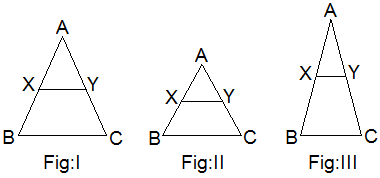
Table,

Conclusion: Hence it is
experimentally verified that a line segment joining the mid-points of any two
sides of a triangle is parallel to third side and is equal to half of its
length.
Theoretical Proof:

Given: ABC is a triangle in
which AX = XB and AY =YC.
To prove: XY∥BC and XY = BC/2
Construction: CZ is drawn such
that it is parallel to BX and XY is produced to meet at Z.
Proof:
Statements Reasons
1. In ∆AXY and ∆YCZ
i. ∠XYA = ∠ZYC (A) --------> VOA.
ii. AY = YC (S) -------> Given.
iii. ∠XAY = ∠ZCY (A) -------->
Alternate angles.
2. ∆AXY ≅ ∆YCZ --------> By ASA axiom.
3. AX = CZ --------> Corresponding sides of congruent
triangles.
4. AX = BX --------> Given.
5. CZ = BX -------> From statements 3 and 4.
6. CZ ∥ BX --------> By
construction.
7. XBCZ is a parallelogram. ------> Being opposite sides
equal and parallel (5. And 6.)
8. XY = YZ i.e. XY = XZ/2 ------> Corresponding sides of
congruent triangles.
9. XZ∥BC and XZ = BC ------->
Opposite sides of a parallelogram.
10. XY∥BC and XY = BC/2
-------> From Statements 9 and 8.
Proved.



0 comments: